Evolutionary game analysis of promoting the development of green logistics under government regulation
Yu Dong ,and Tingting Yang
School of Management,University of Science and Technology of China,Hefei 230026,China
Abstract: Due to the strong negative externalities of traditional logistics,the green logistics that developed from traditional logistics has the advantages of saving resources and protecting the environment.However,in the competitive market environment,enterprises will not implement green logistics based on their own revenues and competitiveness and,instead,will choose the best choice from the actions of a series of internal and external factors.To explore the effect of various factors on the implementation of green logistics by enterprises,this study constructs a tripartite evolutionary game model of the governments,logistics enterprises,and users from the perspective of the participants in the process of logistics greening and analyzes the evolutionarily stable strategies of each participant under different situations.Netlogo software is used to simulate and analyze the initial willingness of the participants,the intensity of government subsidies and fines,and the probability that the enterprises’ speculative behaviors are founded on the system’s evolutionary paths and results.The results demonstrate that the initial willingness of the governments,logistics enterprises,and users to participate has different effects on the evolutionary results of the system.Government subsidy and fine measures significantly impact the strategic choices of enterprises and users.Compared with users,enterprises are more sensitive to government subsidies,and compared with fines,government subsidies have a greater impact on enterprises’ behavior choices.Moreover,the governments should strengthen the publicity of green logistics,formulate judgement standards and an evaluation system for green enterprise logistics,and restrain the speculative behaviors of enterprises.
Keywords: green logistics;evolutionary game;government regulation
1 Introduction
According to the data of the National Bureau of Statistics of China,in 2018,the energy consumption of transportation,warehousing and postal services was about 436 million tons of standard coal,and the carbon dioxide emissions were about 770 million tons,accounting for 9.2% of China’s total energy consumption and 7.8% of China’s total carbon dioxide emissions.In order to implement the CPC Central Committee’s strategic deployment of “carbon peak,carbon neutrality”,the logistics industry shoulders an important mission to achieve carbon emission reduction.However,the whole process of traditional logistics activities will inevitably produce negative externalities,such as the use of chemicals during storage,exhaust gas and noise pollution during vehicle emission and transportation,and the abuse of packaging materials.This will not only endanger the ecological environment,affect the wellbeing and interests of the public,but also waste natural resources,which does not meet the strategic requirements of sustainable economic and social development,causing longterm economic stagnation or regression.
Due to the many negative externalities in traditional logistics activities,green logistics has gradually entered the public eye.In the early days,the public did not pay much attention to green logistics.Due to the increasingly prominent environmental and resource problems in recent years,domestic and foreign scholars and business managers have begun to focus on green logistics[1-3].In addition,monographs on green logistics theory and methods have been published successively[4,5],and Murphy and Poist[6]pointed out that academic interest in logistics environmental issues appears to be growing,with a growing interest in green logistics.
Subsequently,different scholars and relevant organizations have defined green logistics according to their own understanding.Wu and Dunn[7]believed that producing a product from scratch is inseparable from the role of green logistics:from the acquisition of raw materials to the production and processing,packaging design,transportation,and circulation of products to the final delivery to users.This is the positive logistics process,but reverse processes such as waste recycling and disposal are also a part of green logistics.The Reverse Logistics Executive Committee believes that green logistics is a logistics process that minimizes its impact on the ecological environment.In the “Logistics Term” (GB/T 18354-2001) promulgated in China in 2001,green logistics was defined as the process of refining the logistics environment in the logistics process,reducing the negative impact of logistics on the environment,and maximizing the use of logistics resources[8].While many Chinese scholars[9-11]have adopted this definition,other scholars have explained the definition of green logistics from the perspective of its characteristics.For example,Chen[12]believed that the green support of green logistics to the environment and products constitutes its double green characteristics.Feng[13]believed that green logistics is an economic activity process that connects the subject of green supply and demand and ensures the rapid flow of green goods or green services.
Additionally,many scholars are proposing suggestions to promote the development of green logistics from the perspective of policy.Pigou[14],the founder of welfare economics,believed that due to the difference between marginal private net output value and marginal social net output value,it is impractical for neoclassical economics to posit that the optimal allocation of resources is formed entirely by relying on the market mechanism to realize a Pareto optimization.Therefore,it is necessary to rely on government taxation and regulation to address the widespread externalities in economic activity.North[15]believed that externalities exist when the individual costs caused by individual actions are not equal to the social costs and the individual benefits are not equal to the social benefits.Usually,the existence of externalities will lead to unreasonable resource allocation (or low efficiency),that is,“market failure”.Gong and Jing[16]summarized the practical exploration and typical experience of the development of green logistics at home and abroad,combined with the new needs of China’s economic and social green development,evaluated the characteristics and shortcomings of the existing research,and proposed that it is of great importance to build a theoretical framework system of logistics systems with green development as the basic content.Li et al.[17]demonstrated that the policy system can directly affect the willingness to implement green logistics.Liang[18]analyzed the risks of negative externalities of enterprises from two aspects of time and space and pointed out that the governments should formulate incentive policies from three specific levels—industry,taxation,and procurement—to encourage enterprises to bear corresponding responsibilities and achieve sustainable development.
In addition,some scholars have made suggestions on modern green logistics management methods and concepts.Agyabeng-Mensah et al.[19]took a positive attitude towards implementing green logistics management and believed that it has a significant positive impact on the environment.Chen[20]believed that modern green logistics management is a new type of logistics management that meets the development requirements of the times and the interests of human survival and development.He discussed the theoretical basis of sustainable development,ecological economics and ecological ethics of modern green logistics management and argued that the non-green factors that may affect the environment include the six elements that constitute modern logistics.Finally,researchers have proposed strategies for modern logistics management and its development.These include specific suggestions from the perspective of the construction of a logistics management mode and system,such as green logistics development planning,shaping green logistics brands,and choosing green transportation strategies[21,22].
In recent years,some scholars have used game theory to study the development of green logistics and have achieved important research results[23-26].However,there are still some deficiencies in the existing research.First,most of the existing researches are based on the complete rationality of the participants,while the bounded rationality assumption of evolutionary games can effectively compensate for the shortcomings of the former.Second,users are not included in the game behaviors.In China,with the development of the economy,the public’s sense of social responsibility is increasing.After understanding the positive impact of green logistics on the social environment,users will be more inclined to support green logistics.However,due to obstacles such as information asymmetry and opacity in the logistics market,enterprises might have to speculate without government regulation and label traditional logistics as green logistics to deceive users.Consequently,to promote the process of logistics greening,this paper constructs a tripartite game model of governments,logistics enterprises,and users using evolutionary game theory,discusses the strategic choice under different circumstances,and simulates the influence of various parameters on the evolutionary paths and results of the system through a numerical simulation.
2 Methods
2.1 Model assumptions and construction
The implementation of green logistics requires the cooperation of governments,logistics enterprises and users.Based on evolutionary game theory,this paper takes the participants of enterprise logistics greening as the research center and constructs an evolutionary game model that includes three types of subjects:governments,logistics enterprises and users;they are bounded rational participants with the ability to learn and seek the best decision to pursue their own maximized economic utility.The assumptions about the model are as follows:
Assumption 1.In this game model,governments have two strategies—to regulate or not to regulate;logistics enterprise has two strategies—to implement green logistics or not to implement green logistics;and users have two strategies—to purchase green logistics or to purchase traditional logistics.Since all three participants are bounded rational participants,they cannot make optimal decisions in the initial stage of the game.During the entire game process,the participants will dynamically adjust their strategies through learning and imitation until they reach an evolutionarily stable strategy.
Assumption 2.Drawing on Ref.[27],the governments’regulatory measures include supervision,collection of fines,and subsidies.When governments choose to regulate,they need to invest costscfor environmental protection publicity,environmental monitoring,and corporate supervision.At the same time,they will provide subsidyB1to enterprises that implement green logistics and subsidyB2to users that purchase green logistics;they will also impose finesAon enterprises that do not implement green logistics.When governments choose not to regulate,if enterprises also do not implement green logistics at this time,this will negatively impact resources and the environment,cause a decline in the credibility of the governments,and create governments’ reputation loss set asG.
Assumption 3.Implementing green logistics can improve the environment and resources and save governmentsEin environmental governance costs.When logistics enterprises choose to implement green logistics,the general revenues areT2,and the additional costscwill be invested in the technology research and process management of green logistics.In this case,since the prices of green logistics are higher,enterprises will also increase their revenues byt.When logistics enterprises choose not to implement green logistics,the general revenues areT1.At this time,in the absence of government regulation,enterprises can take measures to raise prices to deceive users by labelling traditional logistics as green logistics,which can also obtain additional revenues oft.However,once enterprises’ speculative behaviors are recognized by users,enterprises will losevin market revenues,where the probability that the enterprises’ speculative behaviors are recognized by users is θ andT2>T1.
Assumption 4.Let the general revenues of users purchasing traditional logistics beR1andR1>R2.When users choose to purchase green logistics,the general revenues areR2.In this case,if enterprises implement green logistics,users will gain additional revenues ofr,which mainly refers to the improvement of service quality;if enterprises adopt speculative behaviors,users will lose the revenues ofs.
The variables are summarized in Table 1.
2.2 Construction of evolutionary game model
Letxdenote the proportion of government groups that choose to regulate and let 1-xdenote the proportion of government groups that choose not to regulate.Suppose thatydenotes the proportion of logistics enterprise groups that choose to implement green logistics,and 1-ydenotes the proportion of logistics enterprise groups that choose not to implement green logistics.Letzdenote the proportion of user groups that choose to purchase green logistics,and 1-zdenote the proportion of user groups that choose to purchase traditional logistics,andx,y,z∈[0,1] are functions of timet.According to the above four assumptions and parameter settings,the three party game payoff matrix is illustrated in Table 2.
3 Tripartite evolutionary model analysis
3.1 Government game equilibrium analysis
According to Table 2,the expected payoff of the government that chooses to regulate isUx1and the expected payoff of choosing not to regulate isUx2.The specific calculation is as follows:
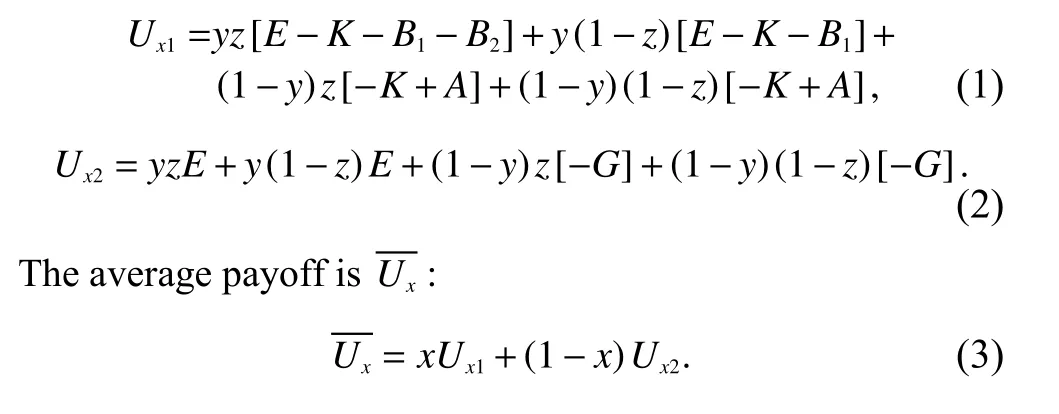

Table 1.Variable description.

Table 2.Payment matrix of governments,logistics enterprises and users.
According to the evolutionary game theory[28],the replicator dynamics equation that governments choose to regulate is

①Wheny=y0,the replicator dynamics equation isF(x)=0.At this time,anyxpoint in the range of [0,1] is an evolutionarily stable point,and the governments’ strategic choices do not change with time.
② Wheny≠y0,letF(x)=0,the two stable points of the governments arex=0 andx=1. DeriveF(x) to obtain

Ify>y0,whenx=0,therefore,the evolutionarily stable point of the governments isx=0.Similarly,wheny<y0,the evolutionarily stable point of the governments isx=1.
According to Eq.(5),when the governments’ regulatory costsKdecreases,y0increases,and governments are more inclined to choose to regulate.The greater thezis,the greater the willingness of users to purchase green logistics,and greater the governments are inclined to choose not to regulate.This demonstrates that if most users have a strong sense of social responsibility and environmental protection awareness,and are willing to purchase green logistics at a higher prices than traditional logistics,then enterprises will implement green logistics to occupy the market share when they see the market demand for green logistics,and in this case,it is feasible that the government does not regulate.
3.2 Enterprise game equilibrium analysis
The expected payoff of logistics enterprises those choose to implement green logistics isUy1,and the expected payoff of choosing not to implement green logistics isUy2.The specific calculation is as follows:
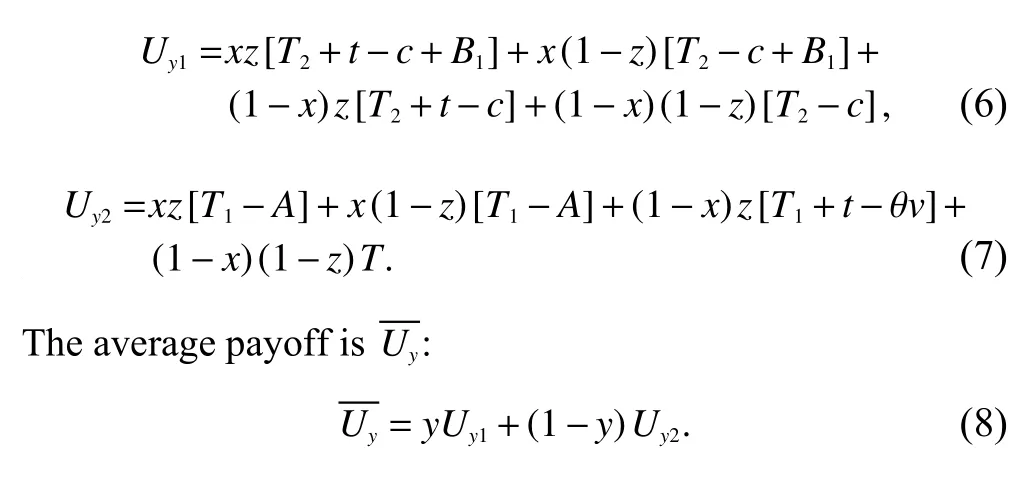
The replicator dynamics equation that enterprises choose to implement green logistics is
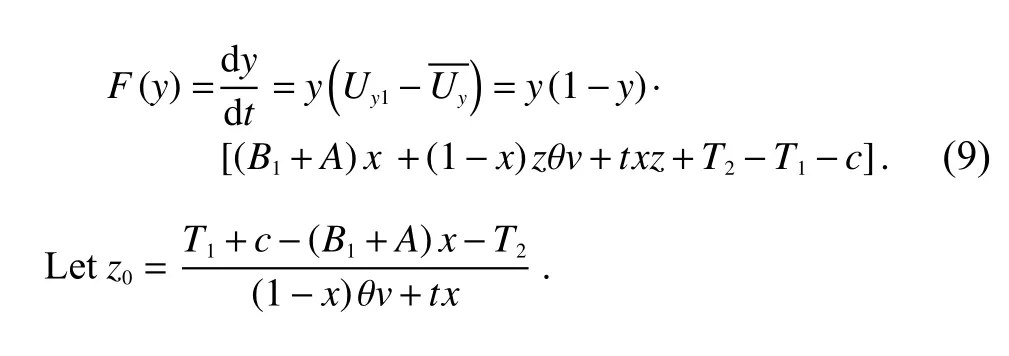
①Whenz=z0,the replicator dynamics equationF(y)=0,at this time,anyypoint in the range of [0,1] is an evolutionarily stable point,and the enterprises’ strategic choices do not change with time.
② Whenz≠z0,letF(y)=0,the two stable points of enterprises arey=0 andy=1. DeriveF(y) to obtain

Ifz>z0,whenwhentherefore,the evolutionarily stable point of the enterprises isy=1.Similarly,whenz<z0,the evolutionarily stable point of the enterpri sesisy=0.
Through the analysis of the replicator dynamics equation of enterprises,it can be found that whether enterprises implement green logistics is mainly related to the costs of investmentc,the government subsidiesB1that can be obtained,finesAthat must be paid for not implementing green logistics,and the probability of being detected as speculative behavior.Whencandz0increase,the willingness of enterprises to choose to implement green logistics is lower.When θ ,B1,andAincrease,z0decreases,and enterprises are more inclined to choose to implement green logistics.From the analysis,the largerxis,the greater the willingness of governments to regulate,the more enterprises are inclined to choose to implement green logistics.This demonstrates that the governments’ actively regulatory behaviors can effectively motivate enterprises to implement green logistics,but it does not mean that as long as governments regulate,enterprises will definitely implement green logistics as the strategic choices of enterprises are mainly related to the intensity of governments’ regulatory behaviors.That is,when enterprises implement green logistics,they can obtain higher government subsidies,but when they have to pay high fines,enterprises will face greater external pressure,and the willingness to implement green logistics will be stronger.Therefore,the governments should strengthen the supervision and management of the behaviors of logistics enterprises and formulate and improve the strict subsidy and fine mechanism to enhance the motivation of enterprises to implement green logistics.
3.3 User game equilibrium analysis
The expected payoff for users who choose to purchase green logistics isUz1,and the expected payoff of choosing to purchase traditional logistics isUz2.The specific calculation is as follows:

The replicator dynamics equation that users choose to purchase green logistics is

①Whenx=x0,the replicator dynamics equationF(z)=0;at this time,anyzpoint in the range of[ 0,1] is an evolutionarily stable point,and the users’ strategic choices do not change with time.
②Ifx≠x0,letF(z)=0,the two stable points of the users arez=0andz=1.DeriveF(z)to obtain

Through the analysis of the replicator dynamics equation of users,the main factors affecting users’ strategy choices are the government subsidiesB2for users who purchase green logistics and the additional revenuesrfor users to purchase green logistics.WhenB2andrincrease,users’ willingness to purchase green logistics will increase.Generally,the market prices of green logistics is higher than those of traditional logistics.When users choose logistics products,they will not only consider the social benefits of products but also be affected by the prices of products.In the absence of government regulation,even if users have a strong sense of social responsibility and green preference,they will worry that they will pay the prices of green logistics but not be able to consume the real green logistics.However,when the governments choose to regulate whether the logistics purchased by users are green or not can not only be guaranteed,but also,the government subsidies can exempt users from economic pressure and stimulate users’ enthusiasm for purchasing green logistics.At the same time,the purchase of green logistics can create additional effects,such as improving service quality and effectively encouraging users to choose green logistics,which requires enterprises to make corresponding facilities in the green logistics market and enhance users’ good consumption experience.Meanwhile,the largeryis,the greater the willingness of enterprises to implement green logistics,and the more users are inclined to choose to purchase green logistics,which demonstrates that the active implementation of green logistics by enterprises can effectively enhance users’confidence in purchasing green logistics.
3.4 Equilibrium analysis of the tripartite evolutionary system
In the previous section,the replicator dynamics equation of governments,logistics enterprises,and users are analyzed separately to explore the critical conditions and related parameters that affect their strategic choices.According to Eqs.(4),(9),and (14),the three-dimensional dynamic system can be obtained,and the interaction of the three parties in the game process is analyzed from the perspective of system dynamics:
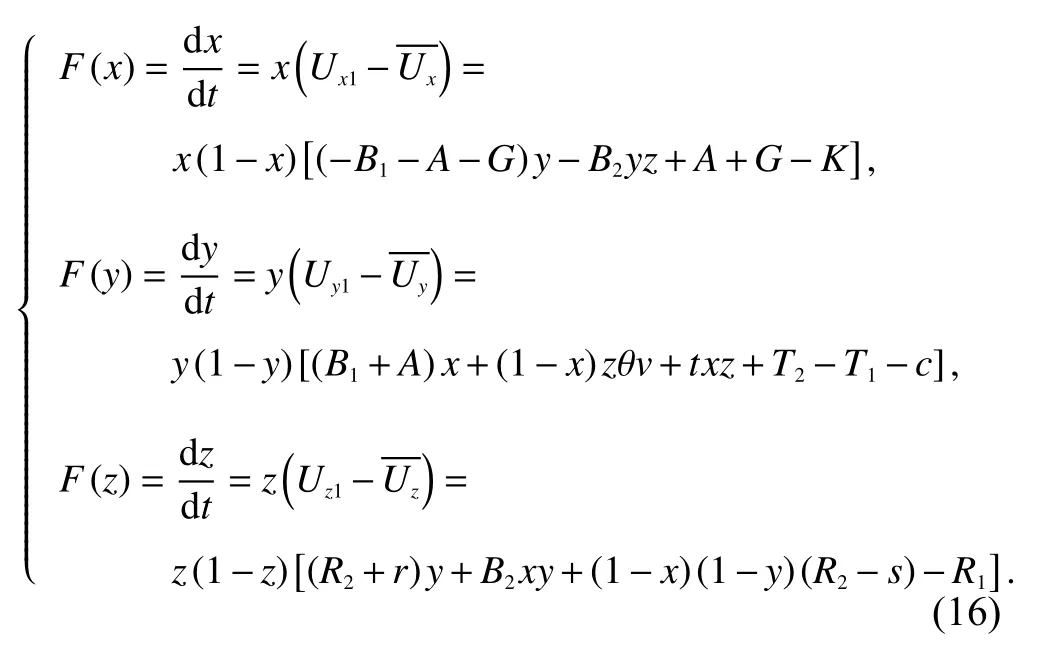
Friedman proposed that by analyzing the local stability of the Jacobian matrix of the differential equation system,the evolutionarily stable strategy of the system can be obtained[29],and the Jacobian matrix of the system is

According to Ref.[30],in an asymmetric game,if the condition of information asymmetry holds,the evolutionarily stable strategy is a pure strategy.Therefore,it is only necessary to discuss the local stability of the eight pure-strategy equilibrium pointsE1=(0,0,0),E2=(0,0,1),E3=(0,1,0),E4=(0,1,1),E5=(1,0,0) ,E6=(1,0,1),E7=(1,1,0),andE8=(1,1,1)that satisfy the equation setF(x)=0,F(y)=0,F(z)=0[31,32].According to Lyapunov’s first law,if the eigenvalues of the Jacobian matrix of each equilibrium point are all negative,the equilibrium point is the evolutionarily stable strategy of the game system.Let the Jacobian matrix corresponding to pointE1=(0,0,0) beJ1;then,The eigenvalues of the Jacobian matrixJ1can be obtained as λ1=A-K,λ2=-c,and λ3=R-r-s.By analogy,the eigenvalues of the Jacobian matrix corresponding to the other seven equilibrium points can be obtained as illustrated in Table 3.
By observing the eigenvalues of each equilibrium point in Table 3,the stability of the system equilibrium point can be analyzed from the following five situations:

Table 3.Eigenvalues of each equilibrium point.
(i) WhenT2-T1-c>0,that is,when there is no government regulation,the revenues obtained by enterprises after implementing green logistics are greater than the expenditures.
(a) WhenR2+r-R1>0,that is,when users’ revenues from purchasing green logistics are higher than those from purchasing traditional logistics,the system will gradually stabilize at pointE4=(0,1,1).This situation is the ideal state we hope to see;even if the governments do not regulate,the total revenues of enterprises implementing green logistics are greater than those of enterprises not implementing green logistics,and users’ revenues from purchasing green logistics are greater than that from purchasing traditional logistics.After comparing the revenues under the two options,enterprises will tend to implement green logistics,and users will tend to purchase green logistics.
(b) WhenR2+r-R1<0,that is,when the enterprises implement green logistics,users’ revenues from purchasing green logistics are less than those from purchasing traditional logistics;then,the evolutionarily stable point of the system isE3=(0,1,0).In this case,the motivation of enterprises to participate in the implementation of green logistics comes from the revenues obtained from investment and does not depend on the government regulation.
(ii) WhenT2-T1-c<0 ,B1+A+T2-T1-c>0,θv+T2-T1-c>0,that is,in the absence of government regulation,the revenues obtained by enterprises after implementing green logistics are less than the expenditures,and the revenues are higher when taking speculative behaviors,but in the case of government regulation,they are higher when enterprises implement green logistics.
(a) WhenR2-R1-s>0,that is,when enterprises have speculative behaviors,the revenues of users purchasing green logistics are greater than those of traditional logistics,and the evolutionarily stable point of the system isE4=(0,1,1).In this case,even if the enterprises may be speculative,users will tend to purchase green logistics based on their own revenues.Since the sum of the revenues and government subsidies received by enterprises to implement green logistics is greater than the expenses,government regulation can effectively motivate enterprises to implement green logistics in the initial stage of the game.
(b) WhenR2-R1-s<0,R2+r-R1>0,that is,users obtain more revenues from purchasing green logistics than traditional logistics,but the result is the opposite when enterprises adopt speculative behaviors.IfA+G-K<0,that is,when the revenues from government regulation are less than the credit loss caused by non-regulation,the evolutionarily stable point of the system will be located betweenE1=(0,0,0) andE4=(0,1,1);otherwise,the system will gradually stabilize at pointE4=(0,1,1).This situation is similar to the previous situation;the governments are willing to participate in regulation at the initial stage to guide enterprises to participate in the implementation of logistics greening.
(c) WhenR2+r-R1<0,that is,when there are speculative behaviors in enterprises,the revenues obtained by users from purchasing green logistics are less than those of purchasing traditional logistics.IfA+G-K<0,the evolutionarily stable point of the system will be located betweenE1=(0,0,0)andE3=(0,1,0);otherwise,the system will gradually stabilize at pointE3=(0,1,0).Since the sum of the revenues and government subsidies received by enterprises from implementing green logistics is greater than the expenditures,enterprises are more inclined to choose to implement green logistics.However,for users,if there are speculative behaviors of enterprises,then they pay the prices of green logistics but do not obtain the real green logistics services,which will damage their own income.Therefore,users are reluctant to take this risk and will be more inclined to purchase traditional logistics.
(iii) WhenB1+A+T2-T1-c>0,θv+T2-T1-c<0,that is,the sum of the revenues and government regulation obtained by enterprises from implementing green logistics is greater than the expenditures,the revenues of enterprises’speculative behaviors are greater than the total revenues of implementing green logistics.
(a) WhenR2-R1-s>0,ifA+G-K<0,then the evolutionarily stable point of the system isE2=(0,0,1).That is,when the benefits of government regulation are less than the loss of reputation caused by non-regulation,the governments are more inclined not to regulate.If the governments’ choices are not to regulate,enterprises will choose speculative behaviors,but even if enterprises adopt speculative behaviors,users’revenues from purchasing green logistics are greater than traditional logistics,so users’ best choice is to purchase green logistics.
(b) WhenR2-R1-s<0,ifA+G-K<0,then the evolutionarily stable point of the system isE1=(0,0,0).In this case,based on the consideration of their own revenues,governments will tend not to regulate,enterprises will tend not to implement green logistics,and users will tend to purchase traditional logistics.
(iv)WhenB1+A+T2-T1-c<0,θv+T2-T1-c>0,that is,the revenues of not implementing green logistics are higher under government regulation,and the revenues of implementing green logistics are higher in the absence of government regulation.
(a) WhenR2-R1-s>0,the evolutionarily stable point of the system is located betweenE4=(0,1,1) andE5=(1,0,0).At this time,since users have greater benefits from purchasing green logistics,the active implementation of green logistics by enterprises can effectively motivate users to purchase green logistics.
(b)WhenR2+r-R1>0,R2-R1-s<0,ifA+G-K<0,the evolutionarily stable point of the system is located betweenE1=(0,0,0) andE4=(0,1,1);otherwise,the evolutionarily stable point of the system is located betweenE4=(0,1,1)andE5=(1,0,0).
(c) WhenR2+r-R1<0,ifA+G-K<0,the evolutionarily stable point of the system isE1=(0,0,0);otherwise,the evolutionarily stable point of the system isE5=(1,0,0).In t hi s case,even if governments choose to regulate,enterprises can obtain subsidies for implementing green logistics,but the final revenues are still less than the expenditures,so enterprises tend not to implement green logistics.Similarly,users are more inclined to purchase traditional logistics.
(v)WhenB1+A+T2-T1-c<0,θv+T2-T1-c<0,that is,the revenues of not implementing green logistics are higher in the case of government regulation,and the revenues of adopting speculative behaviors are higher in the absence of government regulation.
(a) WhenR2-R1-s>0,ifA+G-K<0,the evolutionarily stable point of the system isE2=(0,0,1);otherwise,the evolutionarily stable point of the system isE5=(1,0,0).In the case that governments choose regulation,as the subsidies and fines are relatively light,enterprises tend to not implement green logistics on the premise of only considering revenues,while users choose to purchase green logistics as a better choice.However,enterprises will adopt speculative behaviors quicker when the governments choose not to regulate.Users will also choose to purchase traditional logistics after knowing the choice of enterprises.In this case,the government’s main regulatory strategy should be to increase fines or subsidies and reduce the speculative behaviors of enterprises.
(b)WhenR2-R1-s<0,the governments’choices to regulate depend on the need to meetA+G-K>0;that is,when the revenues obtained by government regulation are greater than the reputation loss caused by non-regulation,pointE5=(1,0,0)is the evolutionarily stable point of the system;otherwise,the evolutionarily stable point of the system isE1=(0,0,0).In this case,after measuring their own revenues,enterprises and users will choose not to implement green logistics and purchase traditional logistics,respectively.
4 Numerical simulation
Based on the evolutionary game model constructed above,the content of this section will use the ABM simulation method[33]to simulate the evolutionary paths of enterprises implementing green logistics from the bottom to the top,from the perspective of microinteraction to macroemergence.This section uses Netlogo software as a multiagent simulation modelling tool to specifically simulate the influence of each player’s initial willingness to participate,the intensity of government subsidies and fines,and the probability that the enterprises’speculative behaviors are founded on the evolutionary paths and evolutionary results.Under the premise of meeting the basic requirements of the model,considering the actual situation and the principle of equality balance[34],let the initial parametersB1=2,B2=1,c=7,T1=8.5,T2=10,R1=4,R2=3.5 ,s=2,r=2,A=2,G=5 ,K=9,θ=5,v=20,t=7,andx0=y0=z0=0.5,andx0,y0,andz0represent the proportion of the governments choosing to regulate in the initial stage,the proportion of logistics enterprises choosing to implement green logistics in the initial stage,and the proportion of users choosing to purchase green logistics in the initial stage,respectively.The magnitude relationship between each parameter value is consistent with the situation in iv(b) of Section 3.4;that is,to explore which parameters affect the final evolutionarily stable strategy of the system and the degree of influence.
4.1 The effect of enterprises’ initial willingness to participate on evolutionary results
Assuming other parameters remain unchanged,Figs.1 and 2 illustrate the impact of changes in users’ initial willingness on the system’s evolutionary results when the initial willingness of the governments and enterprises are both 0.5.In Fig.1,when the initial willingness of the governments,enterprises,and users are all 0.5,the evolutionarily stable point of the system isE1(0,0,0);that is,the governments choose not to regulate,and the enterprises and users choose not to implement green logistics and purchase traditional logistics,respectively.
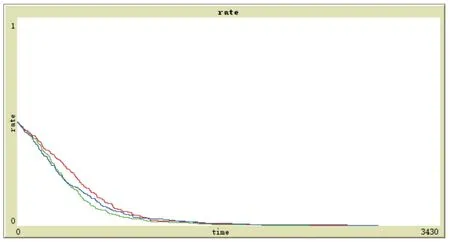
Fig.1.Evolutionary path whenx0=y0=z0=0.5.

Fig.2.Evolutionary path whenx0=y0=0.5, z0=0.9.
When the user’s initial willingness increases to 0.9,the stable evolutionary result of the system changes,and the final evolutionarily stable point isE4(0,1,1).This demonstrates that the change in users’ initial willingness has a greater impact on enterprises.As evident in Fig.2,when the proportion of users who are inclined to purchase green logistics is between 0.9 and 1,the proportion of enterprises inclined to implement green logistics grows slowly.When all users choose to purchase green logistics,the proportion of enterprises participating in the implementation of green logistics will increase sharply,demonstrating that when all users have established the concept of green consumption,it will greatly encourage enterprises to implement green logistics.Therefore,the governments should increase the publicity of green logistics via news and network media.Only when the governments’ publicity and advocacy are in place can the public and users truly understand the characteristics and advantages of green logistics,establish the concept of green consumption,and stimulate the market demand for green logistics.At the same time,it can also let logistics enterprises understand the governments’ policies and regulation and guide enterprises to participate in logistics greening.
4.2 The effect of governments’ initial willingness to participate on evolutionary results
Assuming other parameters remain unchanged,Figs.1,3,and 4 illustrate the impact of changing the governments’ initial willingness to participate in the strategic choices of enterprises and users when the initial participation willingness of the enterprises and users is 0.5.As evident from Figs.3 and 4,when the governments’ initial willingness to participate is 0.7 and above,the final evolutionarily stable point of the system isE4(0,1,1).As the governments’ initial willingness increases,the time for enterprises and users to reach the evolutionarily stable strategy decreases,indicating that the governments’ positive regulatory behaviors can effectively motivate enterprises and users to choose environmentally friendly strategies.
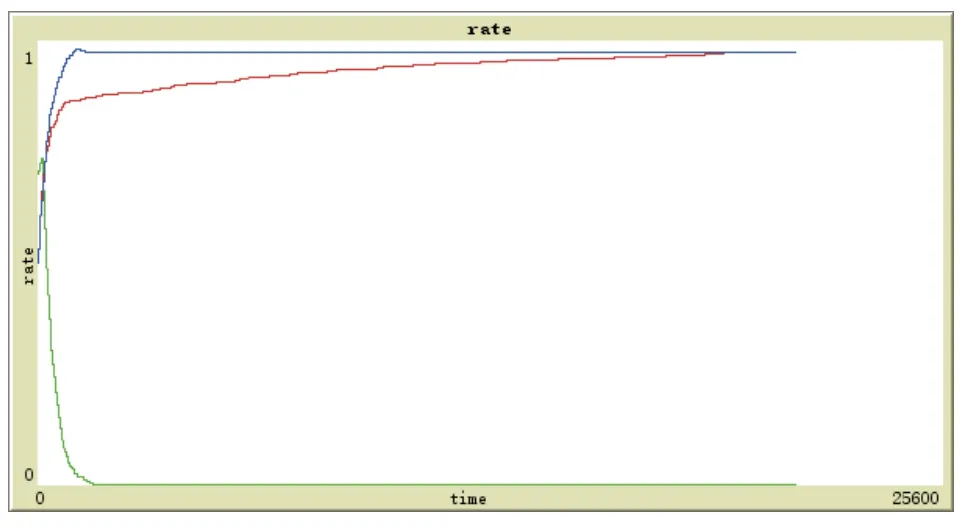
Fig.3.Evolutionary path when y0=z0=0.5, x0=0.7.

Fig.4.Evolutionary path when y0=z0=0.5, x0=0.9.
From the three figures,the change in the governments’ initial willingness to participate can effectively affect the strategic choices of enterprises and significantly shorten the time for enterprises to reach the evolutionarily stable point,but the time for users to reach the evolutionarily stable point in Figs.3 and 4 is not much different.This demonstrates that changes in the governments’ initial willingness to participate have a greater impact on enterprises’ strategic choices.
4.3 The effect of users’ initial willingness to participate on evolutionary results
Assuming other parameters remain unchanged,Figs.1,5,and 6 illustrate the impact of changing the initial participation willingness of enterprises on the strategic choice of the governments and users when the initial participation willingness of the governments and users is 0.5.When the initial willingness of enterprises to implement green logistics is 0.7 and above,the system reaches an evolutionarily stable state;that is,the governments tend not to regulate,the enterprises tend to implement green logistics,and the users choose to purchase green logistics.
Comparing Figs.5 and 6,we can see that the governments’willingness to choose to regulate in Fig.5 tends to decline after a period of growth,but in Fig.6,the government’ willingness to regulate has no upwards trend but a direct and slow decline.This situation is what we hope to see;that is,when the initial willingness of enterprises to implement green logistics is large enough,there is no need for the governments to regulate.
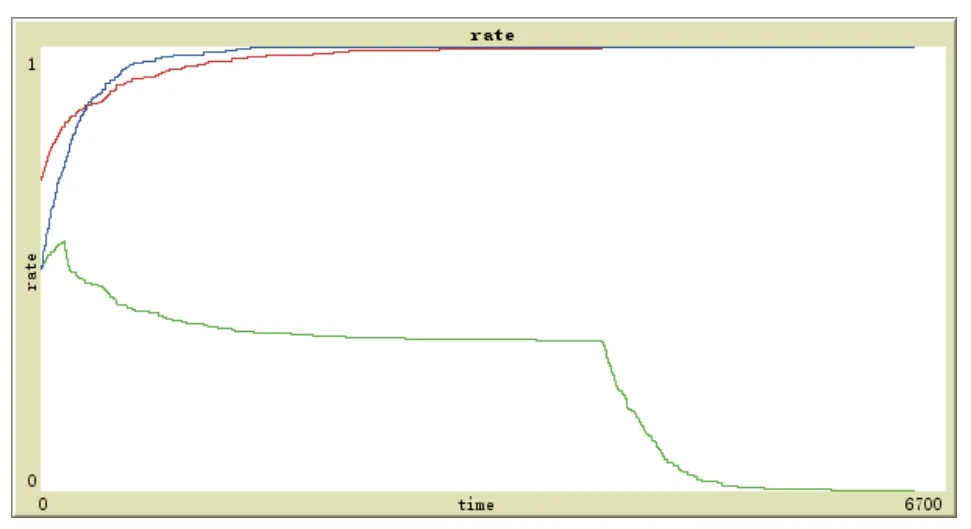
Fig.5.Evolutionary path when x0=z0=0.5, y0=0.7.

Fig.6.Evolutionary path when x0=z0=0.5, y0=0.9.
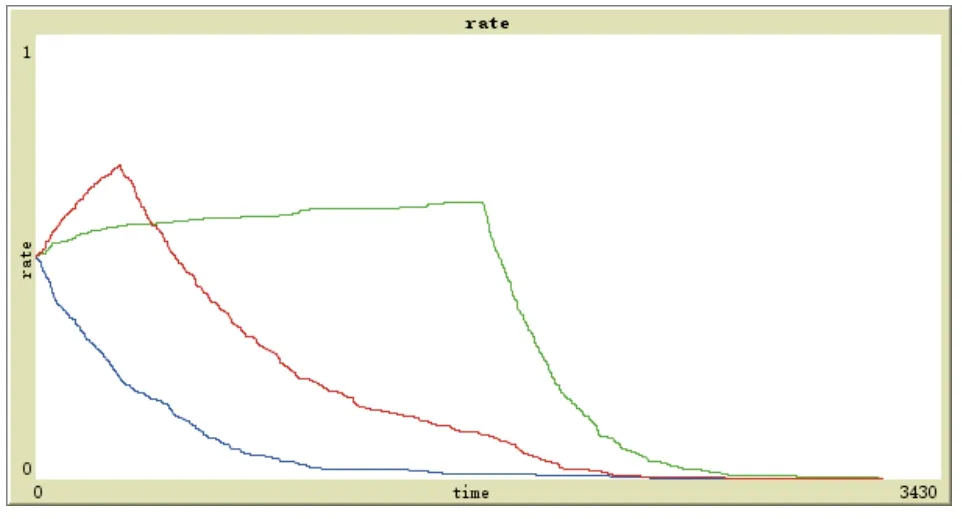
Fig.7.Evolutionary path when B1=2.7.

Fig.8.Evolutionary path when B1=2.8.
4.4 The effect of government subsidies to enterprises on the evolutionary results
Assuming other parameters remain unchanged,Figs.1,7,and 8 illustrate the impact of changing the amount of green government subsidies to enterprises on the evolutionary results of the system.Fig.7 shows that,when the amount of government subsidies to enterprises increases by 35%,although the evolutionarily stable result of the system does not change,it has played a certain incentive role for enterprises and users to choose green strategies.The willingness of enterprises to implement green logistics begin to decline after a period of growth,and the decline of enterprises’ willingness to implement green logistics lags behind users,which demonstrates that when enterprises realize that the market of green logistics cannot develop and grow,they are unwilling to continue to implement green logistics at the risk of reducing profits but immediately adjust their own strategies and choose not to implement green logistics.However,due to the relatively small impact on enterprises under lower subsidies,it is difficult for enterprises to implement green logistics.When the subsidy amount is increased by 40%,the system will eventually stabilize in a state where enterprises implement green logistics and users purchase green logistics under the incentive of the governments,demonstrating that higher subsidies have a great impact on the entire game system.Therefore,the governments should invest more subsidies in the early stage to encourage enterprises to implement green logistics and form green logistics management.
4.5 The effect of government subsidies to users on the evolutionary results
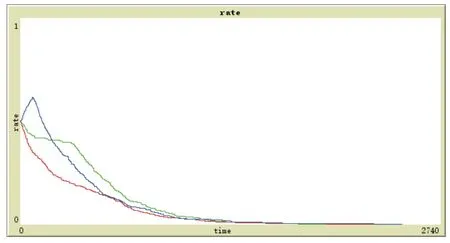
Fig.9.Evolutionary path when B2=1.4.

Fig.10.Evolutionary path when B2=1.5.
Assuming other parameters remain unchanged,Figs.1,9,and 10 illustrate that the evolutionary result of the system is affected by the intensity of government subsidies to users.When the amount of government subsidies to users is increased by 40%,although the proportion of users who purchase green logistics increases at the beginning,the final evolutionary result of the system does not change.It is only when the subsidy amount is increased by 50% that the evolutionarily stable result of the system changes and finally stabilizes at pointE4(0,1,1).This suggests that increasing the amount of subsidies to users can encourage enterprises and users to choose environmentally friendly strategies,but the effect is not as significant as that of subsidizing enterprises.Therefore,when formulating subsidies,the governments should consider the different effects of subsidies on enterprises and users.
4.6 The effect of government fines on enterprises on evolutionary results

Fig.11.Evolutionary path when A=2.9.

Fig.12.Evolutionary path when A=3.
Figs.1,11,and 12 illustrate that when other parameters remain unchanged,the evolutionarily stable result of the system is affected by the intensity of government fines.When the fines amount is increased by 50%,the evolutionarily stable result of the system changes and stabilizes at pointE4(0,1,1).With the increase in the government fines,the speed of the strategy of enterprises and users converging to 1 is also accelerated;that is,the government fines can significantly affect the strategic choices of enterprises and have a greater impact on users.This is mainly because higher fines can inhibit the speculative behaviors of enterprises,reduce the possibility of users being deceived,and help enhance users’confidence in purchasing green logistics.
4.7 The effect of the probability of enterprises’ speculative behaviors were founded on evolutionary results
Under the condition that other parameters remain unchanged,Figs.1,13,and 14 illustrate the effect of the probability of enterprises’ speculative behaviors being founded on the system’s evolutionarily stable results.When the probability of speculative behaviors being founded increases from 0.5 to 0.6,the final strategic choice of enterprises and users changes,and both parties tend to choose environmentally friendly strategies.

Fig.13.Evolutionary path when θ=0.6.
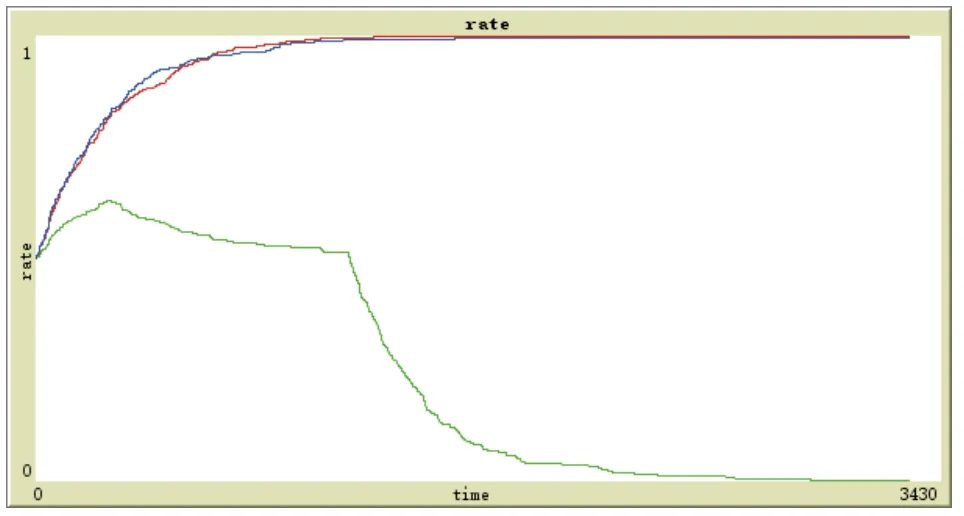
Fig.14.Evolutionary path when θ=0.7.
Figs.13 and 14 indicate that the higher the probability of enterprises’ speculative behaviors being founded,the shorter the time for enterprises and users to tend to an evolutionarily stable state.This demonstrates that the probability of an enterprise adopting speculative behaviors has a greater impact on the evolutionary results.Users can accurately identify whether the logistics they consume are green,which effectively reduces the enterprises’ speculative behaviors.With the development of the economy,public awareness of green issues is also increasing.To meet these needs,the governments should formulate green logistics judgement standards as soon as possible to effectively inhibit the speculative behaviors of enterprises in logistics greening,which will speed up the process of logistics greening.
5 Conclusions
5.1 Research conclusions
Against the background of serious negative external factors in traditional logistics and the urgent need to develop green logistics,this paper takes the subjects involved in the process of logistics greening as the research object,constructs a tripartite evolutionary game model of the governments,logistics enterprises,and users,and analyzes the evolutionarily stable strategy of each participant in different situations.Then,the Netlogo simulation tool is used to simulate the initial willingness of the three parties to participate,the intensity of government subsidies and fines,and the probability of enterprises’speculative behaviors were founded to determine if they impact the evolutionary paths and results of the system.The following conclusions are drawn:
(Ⅰ) The initial participation willingness of the governments,logistics enterprises,and users has different effects on the evolutionary paths and results of the system.The simulation results demonstrate that the initial participation willingness of enterprises has a great influence on users’ strategic choices,while the strategic choices of enterprises are greatly affected by the initial willingness of the governments and users to participate.The initial willingness of enterprises and users has an asymmetric impact,and enterprises are more sensitive to changes in users’ initial willingness to purchase green logistics.Therefore,the governments should strengthen the publicity of green logistics,cultivate users’ preferences for green logistics,expand the market demand for green logistics,and encourage enterprises to implement green logistics.
(Ⅱ) Enterprises are more sensitive to government subsidies than users.The simulation results demonstrate that,based on the initial subsidies,users are willing to purchase green logistics only after the government subsidies to users increase by 50%,while the subsidies to enterprises only need to increase by 40% to make enterprises choose to implement green logistics.Moreover,only when government subsidies reach a high amount can they effectively motivate both enterprises and users to choose environmentally friendly strategies.Therefore,when implementing subsidy strategies,governments should fully consider the different effects of subsidies on enterprises and users and set a different amount of subsidies for them to stimulate the subsidies that reflect the interests of both parties and speed up the process of greening logistics.
(Ⅲ) The government fines have an impact on both enterprises and users,and the stronger the government fines are,the more enterprises and users tend to choose to implement and purchase green logistics,respectively,which demonstrates that fines can effectively solve the problem of negative external factors of traditional logistics.However,enterprises are more sensitive to government subsidies than fines.The simulation results demonstrate that based on the initial subsidies and fines,a 40% increase in government subsidies to enterprises can encourage enterprises to change their strategy choices,while government fines need to be increased by 50% to be effective.Therefore,when formulating policies,the governments should consider the differences in the effects of these two subsidy and fine measures.
(Ⅳ) An important reason for the difficulty of developing green logistics is the speculative behaviors of enterprises.While the speculative behaviors of enterprises damage the interests of enterprises that implement green logistics and discourage enterprises that have not yet implemented green logistics from choosing environmentally friendly strategies,they also weakens users’ confidence in purchasing green logistics.Therefore,the higher the probability of being founded by the users after the enterprises adopt speculative behaviors,the greater the enterprises’ speculative behaviors can be curbed.Given the rapid development of the economy and increasing public awareness,the governments should formulate criteria and an evaluation system of green logistics for enterprises so that users can accurately identify green logistics and traditional logistics and suppress the speculative behaviors of enterprises in the process of greening logistics.
5.2 Limitations and prospects
This paper analyzed the three-party strategy choice in logistics greening from the perspective of a theoretical model.A numerical simulation under the established parameters was carried out,which has a certain deviation from the actual situation.Therefore,the conclusions will be more convincing if the actual data can be obtained to simulate the theoretical model.
In addition,this paper mainly studied the strategic choice of each participant under a static subsidy and fine mechanism and the influence of relevant parameters on each player’s behavioral choice,which can further study the situation under the dynamic subsidy and fine mechanism.Finally,when using the evolutionary game theory to explore the problem of green logistics,we can also consider other participants related to the green process of logistics.
Acknowledgements
This work was supported by the National Natural Science Foundation of China (71973001).
Conflict of interest
The authors declare that they have no conflict of interest.
BiographiesYu Dongis an Associate Professor with the University of Science and Technology of China (USTC) and a Vice President of Anhui University of Science &Technology.He received his Ph.D.degree in Management from USTC.His main research directions are decision science and operation management,and he is interested in the study of game theory in management science issues.
- 中国科学技术大学学报的其它文章
- IITZ-01 activates NLRP3 inflammasome by inducing mitochondrial damage
- Sphingosine-1-phosphate induces Ca2+ mobilization via TRPC6 channels in SH-SY5Y cells and hippocampal neurons
- Comprehensive bioinformatic analysis of key genes and signaling pathways in glioma
- Self-supervised human semantic parsing for video-based person re-identification
- The surrounding vehicles behavior prediction for intelligent vehicles based on Att-BiLSTM

